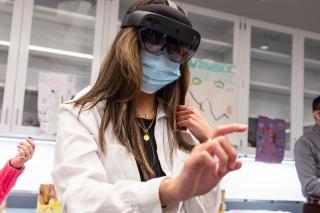Simmons University's College of Natural, Behavioral, and Health Sciences is using HoloLens and HoloAnatomy technology to teach anatomy to undergraduate students. A grant from the George I. Alden Trust is helping to fund this opportunity.
The HoloAnatomy software, created by Case Western Reserve University, uses the Microsoft HoloLens 2 headset to create a hologram representation of anatomy, offering an alternative way to teach anatomy from the traditional cadaver lab. Developed and honed over the last ten years, this technology is now being shared with select partners.
Inspired by the new Simulation Center at Simmons, CNBHS Dean Lepaine Sharp-McHenry is eager to elevate the School of Nursing programs, introducing new ways of educating students. Dean Sharp-McHenry approached Case Western in March of 2022 to get Simmons involved with the technology in this early phase. As a result, Simmons School of Nursing is one of only two nursing schools in the country with access to HoloAnatomy software.
"The software has the full body and systems placed into it, based on the average height and dimension of a male and female body. When we're teaching students we can select different systems and label different things we want them to know," says Biology Teaching Professor Charlotte Russell. "I create a slide deck and choose what I want the students to look at. For example, I can put in histology [the study of the microscopic structure of tissues] slides, along with questions for students to follow. I can also put two dimensional images behind a three dimensional structure."

A lab instructor offers a session to 16 students per lab, with four pods of students in each corner of the room, where the holograms appear. "It doesn't matter which headset they put on, the hologram shows up in the same place, and the instructor is seeing what the students are seeing," says Russell. "Undergraduate students studying anatomy, which includes the nursing students, don't usually perform cadaver dissection, so this is far beyond what they would normally see. It's amazing for them to be able to see normal anatomy in this way."
The magnification function further elevates the hologram experience for students and faculty. "The teacher can move a magnification ring to any part of the hologram, and then to one side you have a bubble with the magnified image of what you're focused on. They can grab it, turn the orientation, and adjust the size," says Russell.
"Students can put their heads into the hologram and see all of the structures from all angles," she adds, which enables students to understand the depth and proximity of different tissues and organs within the body. In one part of her presentation, Russell stands inside the hologram, so students can see where the organs exist in relation to her body. "It answers questions, like, why do you place a stethoscope in one particular spot? They can visualize it, see where the heart is in relation to everything else." Like the hands-on practice offered in the Simulation Labs, the HoloLens technology can further build a student's confidence. "It's valuable for students to make these connections before they are in front of patients in their clinical rotations."
Isabelle Langley '23 is enthusiastic about her experience with the technology. "The new HoloLens technology at Simmons brings a unique way of studying anatomy in the lab!" She reports. "Learning with the HoloAnatomy application is exciting and engaging; it promotes collaboration with peers while studying the material in a way many have never experienced. There is high potential for Simmons students to benefit from using integrative-learning technology."
The HoloLens technology is being used in anatomy and physiology courses, which are prerequisites for a variety of majors. "Our nursing, nutrition, physical therapy, and exercise science students are getting access to this incredible technology," says Russell, who plans to offer the experience for graduate students, now that Simmons has received the George I. Alden Trust grant to fund the purchase of headsets.
"It's exciting, cutting-edge technology that you won't see in every medical school, let alone nursing schools," says Russell. "It's also a group experience, with the students all seeing the same thing and talking to each other, moving around the room and having conversations with other students. It's so much easier to learn blood vessels in three dimensions. This is a gamer generation, and they are very tech savvy, and Simmons is on the crest of this technology wave."
"We're not using the HoloLenses and HoloAnatomy to replace what we are doing in the Anatomy and Physiology sequences," says Russell. "Bringing in new technology enhances all the pedagogy we know is working. Once faculty get to know the program, we'll use it in other courses, across the College." Students unable to use headsets are included by watching a livestream from the instructor's headset in real time. "They can ask questions and be involved," she says. "The feedback we've received from all of our students has allowed us to explore the functionality of the headsets."
Teaching Professor and School of Nursing Chair Chaluza Kapaale applauds the layer of realism that HoloLens brings to Simmons students. "When I was a student, I learned about the different chambers of the heart by looking at drawings on a piece of paper," Kapaale recalls, noting that the one-dimensional representation "didn't make sense conceptually. With HoloLens, you see the size and shape of the chambers [in relation to the entire body], what they actually look like, and the blood flow and valves. The three-dimensional orientation makes sense."
Russell has offered HoloLens demonstrations at Simmons admission events and open houses, as well as for Simmons faculty, Trustees, alumnae/i, and upper administration from area hospitals. "This can only help our connections within the Longwood Medical area," she notes. "They know that Simmons students are prepared for their clinicals!"

